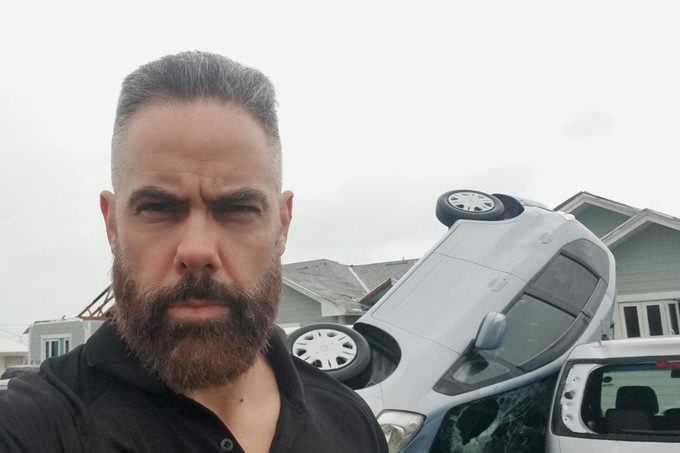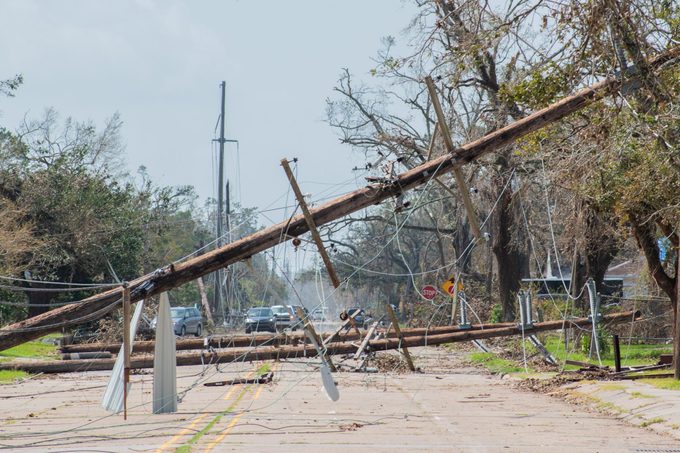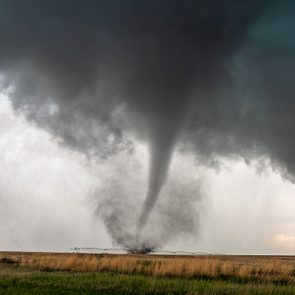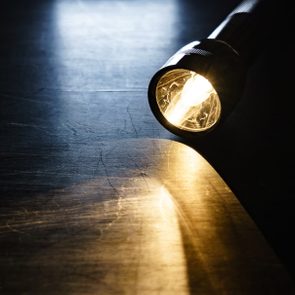I’m a Hurricane Chaser, and These Are the 7 Most Dangerous Mistakes People Make in a Storm
Updated: Sep. 26, 2023

Don't throw caution to the wind! Josh Morgerman, host of Mission: Hurricane, explains common mistakes that could put you in danger during a storm and offers tips for how to survive a hurricane.
You could say I know a thing or two about how to prepare for a hurricane—and even more about how to survive a hurricane. And it’s not because I’ve studied them from a distance. I’ve spent 32 years chasing hurricanes. In that time, I’ve been in some of the strongest hurricanes to ever hit the United States and many of the strongest in the world.
There was the time in 2013 when I was in the central Philippines during Super Typhoon Haiyan. I was in a low-lying city on the tip of a peninsula at the height of the storm. The storm surge—that’s when a hurricane is coming ashore and the wind piles up the ocean water and pushes it onto land—rose like a tsunami, and almost the entire city went underwater. At our hotel, the water was rising, and people were going to drown inside their rooms. So a couple of guys and I smashed the windows and dragged people out, putting them on mattresses and floating them across the lobby to get them up the stairs. Luckily, no one in our hotel died. But outside our hotel, thousands and thousands of people died because they didn’t realize the importance of elevation.
Fact is, if you’re living in an area prone to typhoons or hurricanes, you can increase your chances of being a natural disaster survivor by learning from the mistakes of others. And when it comes to hurricane mistakes, I’ve seen it all.
Avoid dangerous mistakes to survive a hurricane
In my three-decade career as a storm chaser, I’ve added a lot of hurricane names to the list of storms I’ve experienced. I’ve entered the core of 67 hurricanes. For the uninitiated, the core is the calm eye at the center of the storm, plus the eyewall (a ring of the most violent winds and heaviest rains) that surrounds it. The eyewall is where most of the destruction happens. I’m not aware of anyone, dead or alive, who has been in the core of more hurricanes than I have.
Those credentials didn’t just land me the gig of hosting the TV series Mission: Hurricane. They’ve armed me with some truly helpful tips that’ll help you avoid the tragic consequences of a storm. Read on for the top seven mistakes I see people make in a hurricane.
Get Reader’s Digest’s Read Up newsletter for more natural disaster tips, humor, cleaning, travel, tech and fun facts all week long.
Believing distance dictates how safe they’ll be
To survive a hurricane, the No. 1 most important thing to consider is your elevation. Believe it or not, this is even more important than how far you are from the water.
If you’re in a low-lying area, you could be 20 miles inland (or more!), and the storm surge can still get you. Why? Because you’re just two feet above sea level. It doesn’t matter that you’re really, really far from the ocean—you’re not safe.
Don’t believe me? Elevation was partly to blame for what happened in 1957 when Hurricane Audrey struck. People in a town 20 miles from the coast thought they were safe. They weren’t. Hundreds of people in that town died because the water came so far inland.
Likewise, when Hurricane Ian hit Florida (home to the city with the highest hurricane risk on the East Coast) last September, a lot of people drowned in the storm surge because they didn’t understand that their elevation was so low that the water would get them. The storm surge is a hurricane’s biggest killer.
Getting in their cars during the storm

You really don’t want to be in a car during a hurricane, no matter what safe-driving tips you’re following or how badly you want to get out of town.
If you’re in a car, the wind could flip it. A falling tree could crush it. Or a collapsing building could squash it like a little tuna fish can.
In 2019, I was in the Bahamas during Hurricane Dorian, a Category 5 storm. When it was over, the land looked like Siberia in the winter. All the trees had been turned into sticks. Parked cars had been thrown around like toys and mutilated, their hoods torn open and their engines torn out, all from the force of the wind.
The same is true of mobile homes. They’re death traps in any hurricane, even Category 1 storms. Take it from me: Get out of those ASAP.
Overestimating their hurricane experience
Let’s say a Category 4 hurricane comes ashore. Folks outside of the direct hit zone—the section of coast that gets raked by the hurricane’s core—may only see winds gusting to 75 mph and the tide rising a couple of feet. Afterward, they think, “Oh, I survived a Category 4 hurricane.” But they haven’t.
These people have missed the worst of it. So when the next Category 4 hurricane comes, they think, “Oh, yeah, I’ve done this before. I know how to survive a hurricane. It’s no big deal. I’m going to stay in my home.” People die that way.
There’s a big difference in what you experience during a hurricane if you’re in a direct-hit zone. Pay attention to local meteorologists and emergency preparedness messages so you’ll know your risk. If your area is likely to be in a direct-hit zone, evacuate and move to higher ground before the storm hits.
Putting tape on windows
Let me save you some time: Taping your windows is a completely stupid waste of time. It doesn’t do anything to help you survive a hurricane, and it may even make things worse. Don’t do it.
That said, smart homeowners will cover their windows with shutters or boards if they can do it safely before the hurricane arrives.
Opening windows during the storm
There’s this weather myth that says you should open a couple of windows to let the air pass through or ventilate the building … or something. The reverse is actually true: You want your house to be sealed absolutely tight during a hurricane. You don’t want any air to get in. Opening windows is how the roof comes off, and then it’s game over.
Going outside once the storm calms down

You’re in the eyewall, going through the worst part of the hurricane. It’s crazy: Roofs are ripping off buildings. The wind sounds like a train. It’s raining so hard, you can’t see. And then all of a sudden, it stops. Maybe the sun comes out. And it’s so calm—you could build a house of cards outside. That calm can last anywhere from a couple of minutes to hours, depending on how big the eye is.
Many people don’t understand that when they get in the eye, they’re only halfway through the storm. So they go outside and start walking around, and then all of a sudden, the backside of the hurricane hits (from the opposite direction, of course, because it’s a circle). This happens fast: It can go from zero to hurricane force in a minute. Just stay inside.
Driving through standing water after a hurricane
The storm is over, and you have places to be (like the hardware store) and things to do (replacing the mailbox). Or maybe you’re out and about, trying to help others after this natural disaster. While the roads may look drivable without torrents of rain, beware the standing water. Don’t assume you can drive through a portion of the road that’s flooded.
People constantly misjudge the height or the depth of a “puddle.” Do the same, and you risk destroying your car or—worse—losing your life. Think about it: You may not realize just how deep the water is until it’s too late. All of a sudden, the car just dunks in really fast, and it fills with water. Once the water starts coming in, you can’t open the door because of the pressure. It’s a horrible way to die.
The bottom line: When you come across a flooded road after a hurricane, turn the car around.
Safe in the storm
There’s a lot you can do to be ready for the next storm, from stocking up on nonperishable food items to making sure you have a home emergency kit. But understanding how to survive a hurricane goes beyond typical preparedness tasks. You have to be smart in the midst of a storm and after it too.
So learn how to survive a hurricane by committing the tips above to memory and making sure you don’t fall prey to the most common mistakes.
Josh Morgerman is a hurricane chaser and the host of Mission: Hurricane, a 12-episode TV series in which he brings viewers on his most dangerous adventures into the most violent storms around the world. It’s available on the streaming channel WeatherSpy.

















